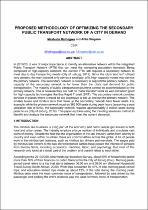 ResearchSpace
ResearchSpace
Proposed methodology of optimizing the secondary public transport network of a city in demand
JavaScript is disabled for your browser. Some features of this site may not work without it.
- ResearchSpace
- →
- Research Publications/Outputs
- →
- Conference Publications
- →
- View Item
| dc.contributor.author |
Rathogwa, Mashudu

|
|
| dc.contributor.author |
Singano, Afika P

|
|
| dc.date.accessioned | 2024-03-01T08:50:11Z | |
| dc.date.available | 2024-03-01T08:50:11Z | |
| dc.date.issued | 2023-07 | |
| dc.identifier.citation | Rathogwa, M. & Singano, A.P. 2023. Proposed methodology of optimizing the secondary public transport network of a city in demand. http://hdl.handle.net/10204/13609 . | en_ZA |
| dc.identifier.uri | http://hdl.handle.net/10204/13609 | |
| dc.description.abstract | In 2019/20, it was of major importance to identify an alternative network within the Integrated Public Transport Network (IPTN) that can meet the increasing population demands. Being composed of high-capacity corridors, the current IPTN still requires a secondary network to meet day to day transporting needs (City of Joburg, 2019). Since the city's land isn't utilized very densely, the main network only serves a small part of it. High-capacity modes may service the primary network. The secondary network is necessary to support the primary network. The capacity of the secondary network is far lower than the city's real demand for public transportation. The majority of public transportation journeys cannot be accommodated by the primary network. This is because they are built on roads that don't work as well and aren't good for high-capacity technologies like Bus Rapid Transit (BRT). The secondary network provides services in places where it would be too expensive to set up and run the primary network. The smaller buses and minibus taxis that make up the secondary network have fewer seats. For example, while the primary network requires 365 000 seats during peak hours (assuming a seat utilization rate of 60%), the secondary network requires approximately 2 million seats during peak hours (City of Joburg, 2019). This paper explores using the traveling salesman method to identify and analyze the secondary network that meet the current demands. | en_US |
| dc.format | Fulltext | en_US |
| dc.language.iso | en | en_US |
| dc.relation.uri | https://satc.org.za/assets/final-announcement-brochure-and-virtual-programme2.pdf | en_US |
| dc.source | 41st Southern African Transport Conference, CSIR International Convention Centre (CSIR ICC), Pretoria, South Africa, 10 - 13 July 2023 | en_US |
| dc.subject | Public transport | en_US |
| dc.subject | Integrated Public Transport Network | en_US |
| dc.subject | IPTN | en_US |
| dc.subject | City of Johannesburg | en_US |
| dc.title | Proposed methodology of optimizing the secondary public transport network of a city in demand | en_US |
| dc.type | Conference Presentation | en_US |
| dc.description.pages | 10 | en_US |
| dc.description.note | Paper presented at the 41st Southern African Transport Conference, CSIR International Convention Centre (CSIR ICC), Pretoria, South Africa, 10 - 13 July 2023 | en_US |
| dc.description.cluster | Smart Mobility | en_US |
| dc.description.impactarea | Passenger Transport | en_US |
| dc.identifier.apacitation | Rathogwa, M., & Singano, A. P. (2023). Proposed methodology of optimizing the secondary public transport network of a city in demand. http://hdl.handle.net/10204/13609 | en_ZA |
| dc.identifier.chicagocitation | Rathogwa, Mashudu, and Afika P Singano. "Proposed methodology of optimizing the secondary public transport network of a city in demand." <i>41st Southern African Transport Conference, CSIR International Convention Centre (CSIR ICC), Pretoria, South Africa, 10 - 13 July 2023</i> (2023): http://hdl.handle.net/10204/13609 | en_ZA |
| dc.identifier.vancouvercitation | Rathogwa M, Singano AP, Proposed methodology of optimizing the secondary public transport network of a city in demand; 2023. http://hdl.handle.net/10204/13609 . | en_ZA |
| dc.identifier.ris | TY - Conference Presentation AU - Rathogwa, Mashudu AU - Singano, Afika P AB - In 2019/20, it was of major importance to identify an alternative network within the Integrated Public Transport Network (IPTN) that can meet the increasing population demands. Being composed of high-capacity corridors, the current IPTN still requires a secondary network to meet day to day transporting needs (City of Joburg, 2019). Since the city's land isn't utilized very densely, the main network only serves a small part of it. High-capacity modes may service the primary network. The secondary network is necessary to support the primary network. The capacity of the secondary network is far lower than the city's real demand for public transportation. The majority of public transportation journeys cannot be accommodated by the primary network. This is because they are built on roads that don't work as well and aren't good for high-capacity technologies like Bus Rapid Transit (BRT). The secondary network provides services in places where it would be too expensive to set up and run the primary network. The smaller buses and minibus taxis that make up the secondary network have fewer seats. For example, while the primary network requires 365 000 seats during peak hours (assuming a seat utilization rate of 60%), the secondary network requires approximately 2 million seats during peak hours (City of Joburg, 2019). This paper explores using the traveling salesman method to identify and analyze the secondary network that meet the current demands. DA - 2023-07 DB - ResearchSpace DP - CSIR J1 - 41st Southern African Transport Conference, CSIR International Convention Centre (CSIR ICC), Pretoria, South Africa, 10 - 13 July 2023 KW - Public transport KW - Integrated Public Transport Network KW - IPTN KW - City of Johannesburg LK - https://researchspace.csir.co.za PY - 2023 T1 - Proposed methodology of optimizing the secondary public transport network of a city in demand TI - Proposed methodology of optimizing the secondary public transport network of a city in demand UR - http://hdl.handle.net/10204/13609 ER - | en_ZA |
| dc.identifier.worklist | 27109 | en_US |





